Welcome to the Ultimate China Train Guide, updated for 2024! I’ve been taking trains in China for more than 10 years now and it is one of the most comfortable and fun ways to explore China. These are all the things you need to know in order to search for the right train, buy train tickets, navigate the China train station and more. Enjoy!
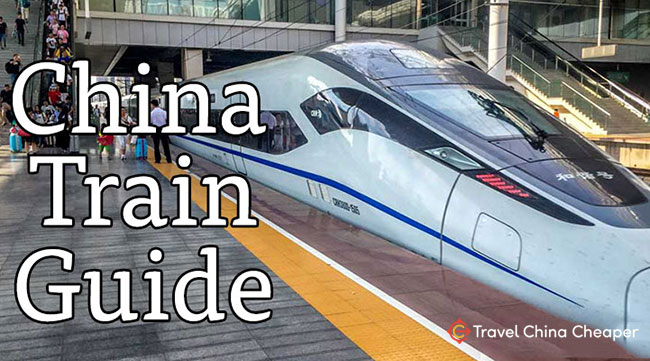
It doesn’t matter if you’re taking a high speed train from Beijing to Shanghai or the slow train from Lanzhou to Urumqi…
…in this guide we’re going to attempt to cover all aspects of train travel in China.
How, you say?
I’m not going to teach you how to buy train tickets in China…you’re going to learn how to buy train tickets in China without standing in a line.
I’m not going to just explain the different types of trains that are operating in China…you’re going to learn which trains have power plugs, what to expect with the toilets and what you need to make sure to bring with you.
But most of all, my goal by the time you finish reading this guide to trains in 2024 is to take away any fear or reservations you have about doing it.
Trust me: it’s easy;
It’s cheap;
And best of all it’s fun.
How do I know? Well…I happen to be writing this while on a high-speed train from Qingdao to Shanghai 🙂

Are you ready? Great! Let’s get started.
Because I’ve worked hard to make this such a comprehensive guide (over 4,000 words!), I’m including a table of contents to help you navigate easily.
Table of Contents
Note: Some links in this article are affiliate links, which means that at no extra cost to you, I may be compensated if you choose to use one of the services listed. I only recommend what I’ve personally used, and I appreciate your support!
If you don’t have time to read it all, just follow the instructions below and I’ll email you a free PDF copy!
Pros and Cons of Taking a Train in China
There are plenty of great reasons to take a train in China – and a few reasons you might want to avoid them.
In general, it is my opinion that the pros far outweigh the cons. Often, however, the choice between a train, bus or flight in China must be considered on a case-by-case basis.
So let’s start this China train guide by looking at the reasons that trains in China are such a popular form of transportation for travelers.
This is true even more so now in 2024.
The Benefits of Taking a Train in China
- Trains Save Money: Taking a train in China is in many instances the cheapest form of transportation. Cases where this might not be true is when taking a high-speed train over long distances. If you’re seriously looking to save money, buying a hard seat or standing ticket is dirt-cheap (albeit incredibly uncomfortable).
- Train Ticket Prices are Set: The best part about buying train tickets is that unlike fluctuating flight prices that make finding cheap China flights difficult, the prices of train tickets don’t fluctuate. They’re set, so you know exactly how much you’ll have to pay.
- Trains Save Time: Taking a train in China can often save time over flying or taking a bus. Train stations are often conveniently located in the middle of a Chinese city, as opposed to most airports which are far outside. In addition, you don’t have to arrive at a train station hours in advance of your departure like you do with flights. I usually arrive about 30-45 minutes ahead of my departure time. China trains are very punctual, unlike flights in China which experience delays or buses which are subject to traffic conditions.
- China Trains are Comfortable: Contrary to what you might imagine, trains in China can be quite comfortable. As a general rule, you get more leg room in a train, better opportunity to walk around, and there’s usually even a restaurant car. Sleeper car beds aren’t bad and the seats in the new high speed trains are much better than airplanes.
- China Trains Offer Beautiful Scenery: Trains offer a unique view of the varied China terrain that rolls by your window. You don’t get this beautiful view when taking a bus or airplane.
- China Trains Offer Cultural Experience: Trains offer a fun cultural experience that is hard to beat. Spending hours with your fellow Chinese passengers, most of whom will be happy to meet you and curious to chat, will provide a window into Chinese culture that you would never have in a bus or airplane. Taking a train in China is even a good opportunity to practice your Mandarin Chinese.
The Drawbacks of Taking a Train in China
As much as I like to talk up the advantages of taking a train during your trip through China, there are a few things you should be warned about before taking a train:
- China Trains Can Get Crowded: This is especially true over major holidays like Chinese New Year. Trains sell standing tickets that can make the cheaper, lower class seats uncomfortable when they’re full of people standing everywhere.
- China Trains Aren’t Always Cheaper: Always do your homework. There are many times where flights have been discounted so heavily that it has been cheaper for me to fly than take a train.
Did You Know…
In 2019, Chinese trains transported a total of 3.57 billion passengers. That’s BILLION with a “B”.
- Train Tickets Regularly Sell Out: Because train tickets are put on sale 30 days prior to departure date and prices don’t fluctuate, buying a “last minute” train ticket can be difficult. As a general rule, I try to buy my China train tickets at least 5 days prior to departure (much earlier for the China holiday season). Anything sooner than that and I risk having to buy either a super-expensive business class or an uncomfortable standing ticket.
- Train Stations Don’t Always Cater to Foreigners: At least not as much as airports do. Many of the older train stations can be confusing for somebody who doesn’t speak a bit of Mandarin. Never fear, though! This is something I hope to help you with in the section on Navigating a Train Chinese Station.
Understanding the China Train “Code”
What most travelers don’t know is that you can tell a lot about your China train by looking at the train route number (i.e. “D2847” vs “K1128”).
Not only can you determine the speed of your train, it’s also usually a good indicator of comfort. In other words…
…it’s good information to have!
Chinese trains are broken down into different categories, which I’m listing in this China train guide starting from the fastest/most comfortable down to the slowest/least comfortable:
China’s High Speed Trains (“G” and “D”)
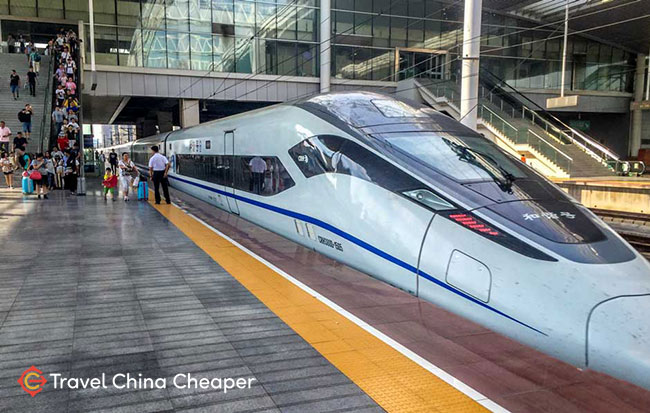
Over the past decade, China has invested heavily in its network of high speed railways, and has plans to continue this investment for the next decade.
The high speed rail is divided into two categories – “G” and “D”.
Aside from the speed and an extra class, they’re more similar than they are different. Both categories usually have western (i.e. seated) toilets (if you’re curious, here’s what to expect with China’s toilets as a whole) as well as power plugs on *most* 1st class seats and all business class and premium seats.
- G – The “G” train, short for “Gaotie” which means “high speed train,” is the newest, fastest and usually the most comfortable China train. It’s also the most expensive. These trains usually run at speeds of up to 300km/hr and are quickly becoming the future of train travel in China. You can purchase 2nd class, 1st class and Business class tickets on this train.
- D – The “D” train, short for “Dongche”, is often identical to the G train with one exception: speed. These trains don’t exceed 250 km/hr. Still, they’re comfortable and along certain routes don’t add that much more time than the G train. You can purchase 1st class and 2nd class tickets on this train.
A new addition to China’s high speed system is the sleeper train. These trains run overnight and are still listed under the “G” and “D” designations.
China’s Standard Trains
Standard trains are the older version of China’s rail system and rarely exceed 140 km/hr.
Although less common than they used to be before the high speed train came into existence, you’ll still find these standard trains going to smaller cities or throughout less-developed regions of China.
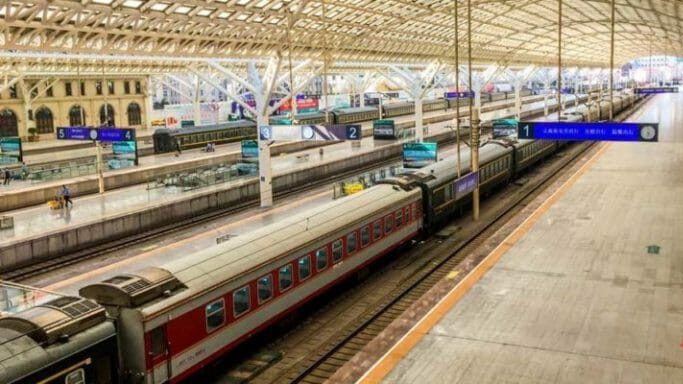
Usually, these trains are divided internally into “Soft Sleeper”, “Hard Sleeper”, “Hard Seat” and sometimes a “Soft Seat”.
They don’t always have a western toilet or air conditioning, but they are cheaper. There are different designations which include:
- Z – The “Z” train is an overnight express train that only runs select routes based on demand. They aren’t common, but it’s usually the fastest of the “standard” China trains – up to 160km/hr.
- T – The “T” train is short for “Tekuai” which means Express Train. These trains are usually special routes between two major cities that run faster than other standard trains because they don’t have many stops in between. The T trains are also less likely to have sleeper options and are more often divided into 1st and 2nd class sections similar to the D train. High speed of 140 km/hr.
- K – The “K” train is short for “Kuaiche” which simply means Fast Train. These used to be the most common – and fastest – trains in China before the era of the high speed train took over. They travel all throughout China between the different provinces.
- Only Numbers – These number trains don’t have a letter before them and are considered “ordinary” trains. If the train begins with 1, 2, 4 or 5, it will be slightly faster than a train whose number begins with 6, 7, 8 or 9. The highest speed of these trains is 100-120 km/hr.
- Other – You may also happen to run across an “L” (temporary train during peak season), a “Y” (tourism) and an “S” (train connecting a city with its suburbs) train, but these are much less common.
A Peek Inside a Chinese Train
As we continue with this ultimate China train guide, let’s take a quick look inside both the high speed and standard China trains.
In this way, you’ll hopefully get a better idea of what to expect on your journey.
Inside China’s High Speed Trains
The two most common ticket classes you can purchase on a high speed train are a 1st class seat or a 2nd class seat.
The difference between the two usually has to do with the size of the seat as well as the personal space allowed.
The 1st Class cars are arranged with two seats on either side of a center aisle. Leg room is plentiful and there are often electrical outlets to plug in your electronic device (although this isn’t always the case).

The 2nd Class cars have a tighter seating arrangement with three seats on one side of the aisle and two on the other.
Leg room feels more like an airplane but the seats are still relatively comfortable. I’ve seen some 2nd class seats that have electrical outlets but as a whole it seems that this isn’t common.
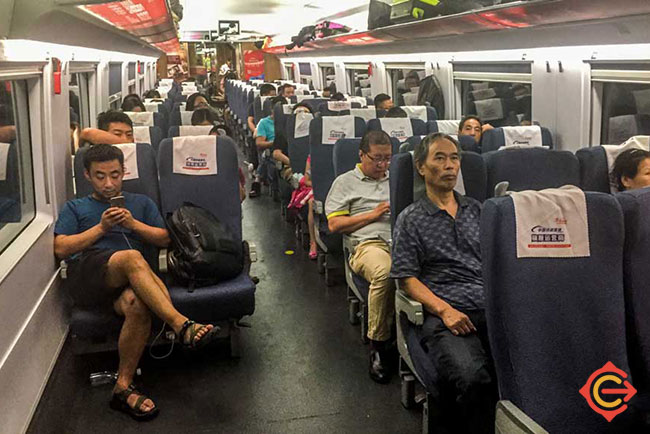
Beyond the 1st and 2nd class cars, you might also find a Business Class in high speed trains.
These comfortable, fully-reclining leather chairs are a treat for any traveler. Beware, though: it’s almost guaranteed to be more expensive than the cost of flying to your destination! Amenities here are similar to what you’d find on an airline business class.
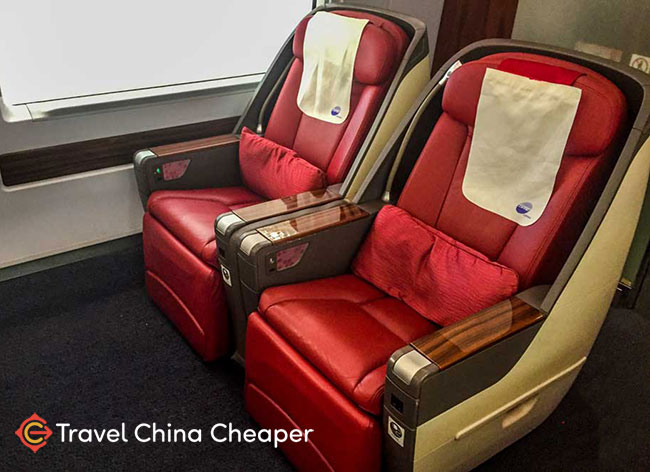
Although somewhat less-common, there are a few high-speed China trains have a super-luxurious class that goes by different names: VIP, Deluxe, Premium, Superior, etc.
These tickets are extremely expensive and usually offer private accommodation on the train, sometimes with your own private bathroom.
China’s high speed overnight trains offer the added luxury of a bed. The most common is lined on both sides with private bunks in two layers. Each compartment has its own light, window, and electrical plug.
My Personal Recommendation
In my opinion, 2nd class seats on a high speed train are comfortable enough for most people and are a great way to save money. However, I find that 1st class is the perfect blend of price and comfort. Plus, I like to work while traveling so I prefer having elbow room and a plug at my seat 😉
Inside China’s Standard Train
China’s standard trains can be arranged to include (or sometimes exclude) the following classes.
First you have the Hard Seat cars (Yinzuo or 银座) that have, as you would expect, hard bench seats set at a 90 degree angle with a table in between.
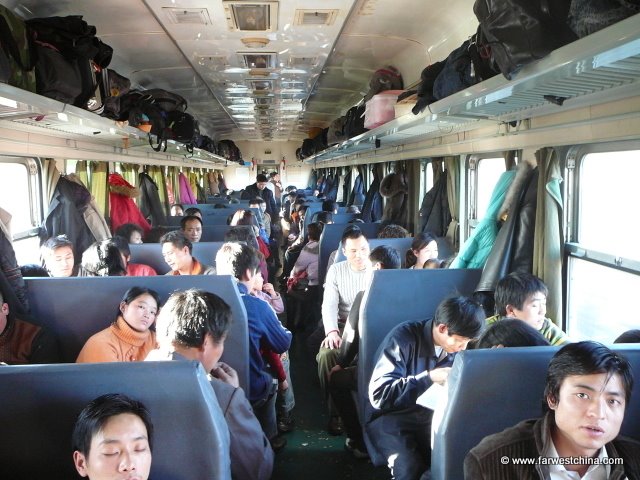
For short rides, these hard seats might not be a bad option. However, it can become incredibly uncomfortable for rides longer than a few hours. There are no electrical outlets and little room for luggage.
A limited number of trains include a Soft Seat car (Ruanzuo or 软座) whose seats would more resemble an airplane economy class, albeit a bit less comfortable. You have more personal space and the ability to slightly recline if you like.
The next step up the average China train is the Hard Sleeper cars (Yingwo or 硬卧), which have berths of six beds – three on each side – with a small table between and no door. These are the tickets which sell out fastest because they are the best mix of price and comfort.
Beds aren’t overly comfortable but at least you can lay down!
These seats are designated as:
- “Shangpu” 上铺 (Top bunk, cheapest)
- “Zhongpu” 中铺 (Middle-bunk)
- “Xiapu” 下铺 (lower bunk, most expensive).
Finally, the best tickets you can buy on the average China train (T, K, P, L) are known as Soft Sleepers (Ruanwo or 软卧), whose berths are comprised of 4 comfortable beds with a door that closes.
In the newer trains, these berths even include a small TV and electrical outlets for your computer and phone (although in my experience the electrical outlets rarely have electricity!).
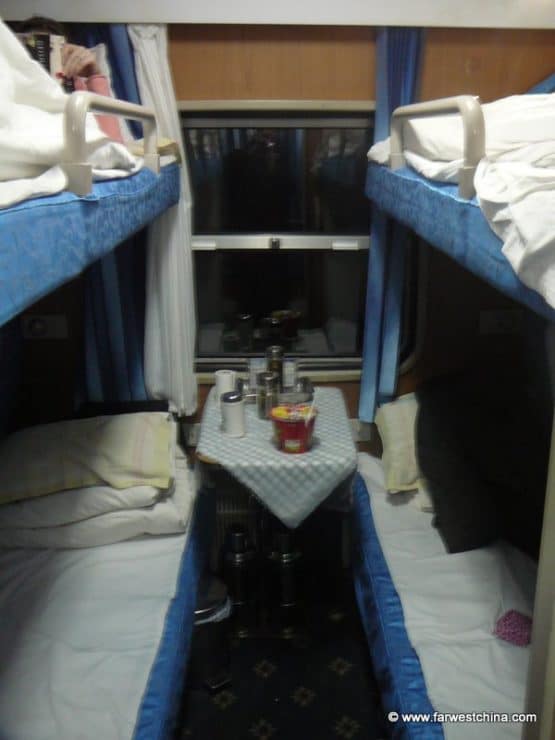
Beds here are good but the price can sometimes rival that of an airline ticket. These tickets are designated as “Shangpu” (Top bunk, cheaper) and “Xiapu” (Bottom bunk, slightly more expensive).
Bathrooms on most regular-speed China trains are squatty toilets and often are not that clean. The only exception is in the soft sleeper car, where there is usually one western-style toilet.
Additional Train Cars
On most trains you’re also likely to find a restaurant car where you can sit down for a meal that can be good but is likely a bit pricey. Feel free to walk around and ask for a menu here.
They won’t let you sit at the tables unless you order, however, so unfortunately you can’t use this as a free place to get away. Trust me…I’ve tried.
Navigating a Chinese Train Station
When talking to most China travelers, they tell me that the Chinese train stations scare them.
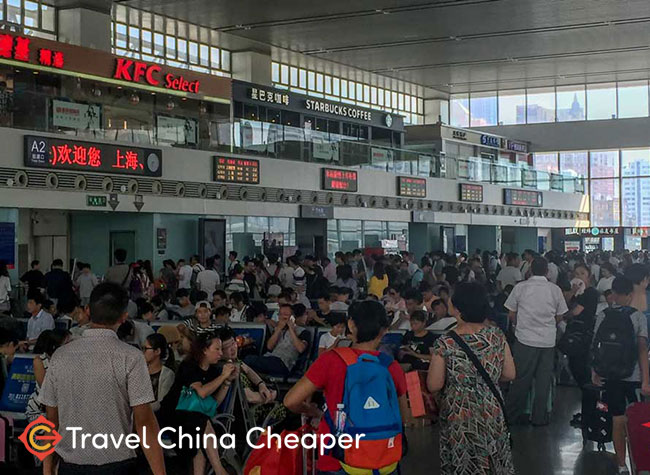
I get it.
They do seem intimidating with their massive labyrinths of halls, stalls and waiting areas. It’s not as impossible as it seems, though, and I intend to direct you clearly in this China train guide.
Every train station in China is different and the newer stations are likely to have more signs in English for you.
Still, there is a basic process to a China train station you should understand:
- Step 1: Get Your Ticket – I’ll go into more detail below on how to buy China train tickets, but for now you should know that every train station has what they call a “Ticket Hall” or 售票大厅 in Chinese. Usually this ticket hall is outside the main entrance to the station and requires you to pass through its own security check to enter.
- Step 2: Show Your Ticket: As you enter the main station, one of the first lines you’ll stand in will be the ticket check, where you will need to present both your ticket and your passport. The agent checks to make sure that your identity on the two match.
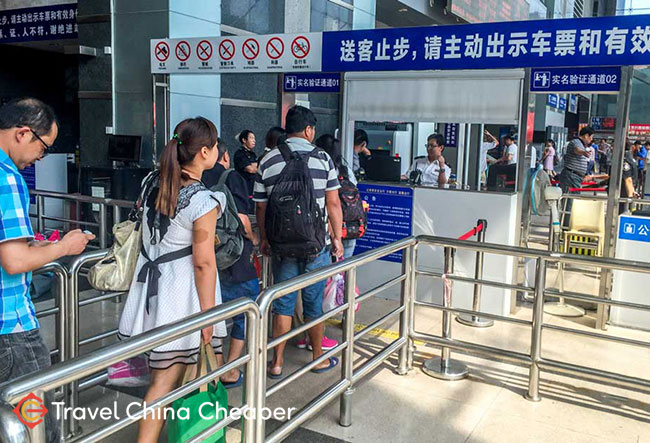
- Step 3: Security Checkpoint: Your next step is to scan your luggage. This is usually the choke point for any train station but thankfully it’s not as bad as airport security. You should keep your shoes and belt on and put your luggage through the scanner. Once you walk through a metal detector, prepare for a quick but harmless pat down by the security guard.
- Step 4: Find Your Waiting Hall/Gate: Don’t be afraid to find somebody who looks like they work there, show them your ticket and give a questioning look. Almost 90% of the time they’ll point you in the right direction. If you can read Chinese, there should be a board that will display your train number (which you can find on your train ticket) followed by the number of the waiting hall or gate from which you’ll depart. Around the waiting area there are usually small stores or fast food restaurants where you can stock up for the trip (although it’s often more expensive than buying outside).
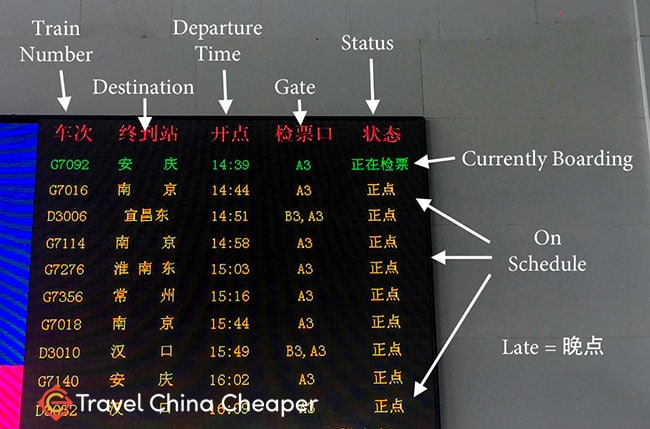
- Step 5: Board Your Train: Somewhere between 15-20 minutes before the departure time of your train, the doors will open and stewards will check your ticket one last time as you head to the train platform. Just follow everybody else and if you’re still confused, find somebody and show them your ticket.
- Step 6: Enjoy the Ride! You’ll be asked to show your ticket while on the train and sometimes even after you depart, so keep it handy.
Train Station Tips
Here are a few pro tips about train stations that I’ve picked up.
- Stock Up Outside: Purchase all your drinks and food at the stores outside the train station. Everything inside the station will be marked up considerably.
- What Makes it Through Security: It’s worth noting that things like drinks and oversized luggage are permitted through security, so don’t forget to stock up on plenty of water!
- What DOESN’T Make it Through Security: Fuel canisters, lighters, knives and other related items.
- Electrical Outlets and Internet: While some Chinese train stations offer free internet, it’s usually slow. It’s also hard to find electrical outlets so make sure you’re charged up before you arrive.
How to Buy China Train Tickets Online
The best part about modern-day China train travel is that most of the ticketing has moved online.
For now, you MUST have a paper ticket in hand to board your train (that might change in the near future). Thankfully though, you can book it from the comfort of your home country and pick it up once you arrive in China.
Let me show you how as part of this China train guide. There are three main ways to book online:
- 12306 Website: The website 12306.cn is the official China railway website and is the best way to purchase train tickets on your computer. Unfortunately, it’s not the easiest. Aside from the website being all in Chinese, it also requires a Chinese phone number and a Chinese bank account. They don’t accept foreign credit cards right now. Still, for those who will be spending a lot of time in China, it’s a good option.
- Phone Apps: I’ve recently fallen in love with the 12306 phone app, available on both Android (direct download link) and Apple iOS. Like the website, it’s only offered in Chinese and requires a Chinese bank card to use. However, I find it useful for the purpose of checking up-to-date availability (all other apps will have a lag). It’s also possible to purchase tickets on the WeChat and Alipay platforms.
- 3rd Party Providers: For most traveler’s, this will be your only option but thankfully it’s not a bad one. 3rd party providers like China Highlights not only allow you to purchase tickets in English and use your foreign credit card, they’ll also arrange to have the tickets delivered to your hotel for you! In every case, these companies charge a fee, but usually it’s only a few dollars per ticket. Check pricing and availability of your China train here below.
Let me stress this – I highly, HIGHLY recommend you purchase tickets online prior to your departure.
Buying tickets in the station ticket hall is time consuming and difficult, particularly if you don’t have a command of the Chinese language.
It is possible to purchase China train tickets up to 30 days in advance of your departure. This and other rules about buying China train tickets have made this mode of transportation very appealing.
How To Pick Up Your Purchased Tickets
Purchasing the China train tickets is only half the battle – now you need to pick them up.
In order to reduce stress, I like to pick up my tickets prior to arriving at the station so I don’t have to stand in line.
How?
I pick up my tickets at an official train ticket office (火车票代售点 or “Huo Che piao dai shou dian”) which are located throughout every city in China. It usually costs about 5 RMB for them to print your ticket but it is completely worth skipping the hassle at the train station.
With only one exception during a holiday season, I have never stood in line at a train ticket office to pick up my tickets.
Make sure you bring your passport and the reference code you were given when the tickets were purchased. It’s a 10-digit code that begins with one letter and ends in 9 numbers (i.e. “E123456789”).
How to Buy China Train Tickets at the Station
Every train station has a ticket hall, and you can stand in line to buy your tickets here.
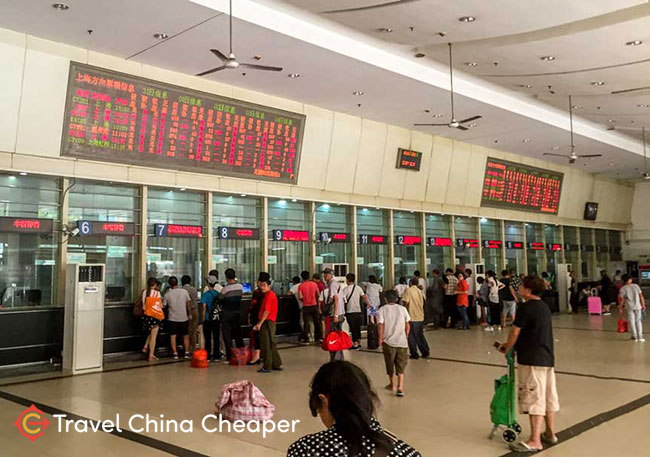
Now before we return to the train station, let me say that even if you don’t buy China train tickets online, it’s possible to use the official train ticket office I just mentioned in the section above to purchase tickets in person. There’s a 5 RMB surcharge but there usually isn’t any line.
For those that, for one reason or another, must purchase their tickets at the train station, make sure you arrive with your passport and cash.
If you’re purchasing for multiple people, you’ll need to have their passports on you as well.
It’s always best to approach the agent with a Plan A, Plan B and Plan C in case you don’t get what you want. I would even recommend you have it written down for convenience.
For instance, let’s say you want to go from Beijing to Shanghai on Friday. Your plan of action might be:
- Plan A: Buy 1st class tickets on Friday; in case that’s sold out…
- Plan B: Buy 1st class tickets on Saturday; if even that’s not available…
- Plan C: Buy 2nd class tickets on either day;
This “Plan A, B, C” method is important because there’s nothing worse than waiting in line only to have your plans foiled and with no backup.
You have to leave the window, regroup with your fellow travelers and stand in line again. I’ve done that before and it’s frustrating.
Understanding Your China Train Ticket
Once you have your ticket in hand, here’s a quick China train guide ticket reference to help you understand what your ticket is telling you.
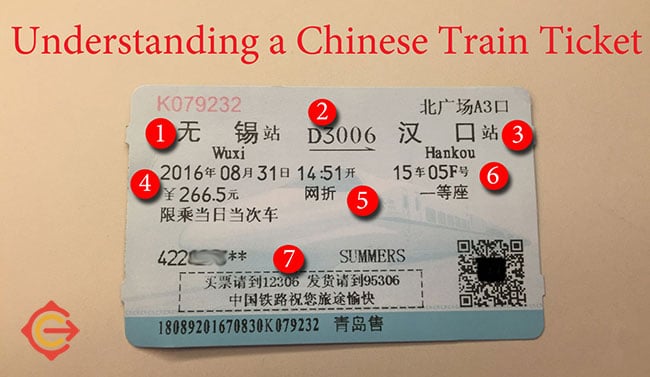
- Departure station: This should be written in both Chinese and English.
- Train Number: This number is specific to your train and tells you the class of the train.
- Arrival Station: Again, this should be written in both Chinese and English.
- Date of Departure: This is written as year/month/day.
- Time of Departure: This is when the train departs. Boarding usually happens 15-20 minutes prior to departure.
- Seat Assignment: The first number is the train car (车) followed by your seat number (号). Below that you’ll see exactly what kind of seat it is (i.e. 1st class, 2nd class, hard seat, soft sleeper, etc.).
- ID Information: The first few digits of your passport and your last name will be toward the bottom, which means that your tickets can’t be transferred to anybody else.
China Train Guide: Frequently Asked Questions

The following are the most common questions I hear about train travel in China. If there are any questions you think I’ve missed, add them in the comments below!
Officially there are luggage weight and size limits on a China train but they’re never enforced. If you can carry it on your person and it fits through a scanning machine, it will be permitted. The only thing to consider is that there’s no such thing as “checking baggage” on a Chinese train. You have to carry and store it by your seat and often there’s not a lot of room to do so.
Train tickets can be purchased 30 days in advance of the scheduled departure date. Note that many train ticket companies will accept reservation requests much earlier than this, but they can’t physically purchase the ticket until they go on sale 30 days prior to departure.
No, you can’t transfer your ticket because it is attached to your passport number. What you can do is return the tickets for a refund or have them changed at the ticket counter, although it’s not the easiest process.
Getting off the train during stops used to be common but is now highly discouraged. More than likely the train stewardess won’t let you leave unless it’s your stop.
After getting on the train, a steward/stewardess will come and check your ticket, making note of where you’re getting off. At each stop, he or she will (usually) come down the aisles calling out the name of the station and in the case of most foreign travelers will come and tell you that it is your stop.
Yes, you can! In fact, I highly recommend bringing food since the food on the Chinese train isn’t that good and is overpriced. Both food and drink are welcome.
Train Tips from Seasoned Travelers | China Train Guide
As somebody who has taken every type of China train to every size of China train station over the past 10 years, I’ve learned a thing or two about how to make the best of the experience.
Hopefully I can pass along some of this wisdom to you.
The following are a few of the “pro tips” I’ve picked up over the years.
- Download the Baidu Maps app on your phone (available for Apple iOS and Android phones).
- Wherever you are in a city, type in “火车票代售点” – or copy and paste it from here – to search for the nearest train ticket office where you can buy or pick up your tickets.
- If you don’t know a lick of Mandarin, download China Highlight’s China Train Booking app (available on Apple iOS and Android). It’s possible to purchase tickets through the app but I find it equally useful for planning, letting you know what trains run on what days and approximately how many tickets are available. Note: If you read Mandarin, the 12306 app does the same thing, but is more accurate.
- When picking your tickets, I recommend the middle bunk (中铺 or “Zhongpu”) of a hard sleeper train or the top bunk (上铺 or “Shangpu”) of the soft sleeper train. The bottom bunks always have people sitting on them during the day and the top bunk of the hard sleeper has too little room between the bed and the train car ceiling.
- Bring hand sanitizer, particularly for longer trips. Bring a small book light if you like to read. Once the lights go out at night during an overnight train, you’re on your own.
- If you’re not sure you’ll have a plug to charge your phone on a long journey, buy a cheap external battery pack on Amazon before you leave or you can find plenty to purchase in China. They’re cheap and they’ll give you an extra full battery or two.
- Noise cancelling headphones are great on airplanes. They’re priceless on a China train – I never leave home without mine! Here is a look at my favorite noise-cancelling headphones for travelers.
- When you get off the train and out of the station, you’re probably going to be mobbed by people yelling “taxi”! Ignore them (I just put headphones on and keep walking). Every train station has a place for official taxis to wait and if you can’t find that just walk to the nearest major street and wait for one. The hawkers you meet will always charge you far more than you should pay and usually aren’t even legal.
- Bring your own entertainment – download movies, take along a card deck or whatever else you like. You’re probably not going to like any movie that might be shown on the train – if there even is one.
Final Thoughts | Enjoy the Journey!
We’ve come to the end of my ultimate China train guide for 2024!
Phew…you made it!
I trust you now feel confident to purchase your own tickets and jump on your train. Enjoy the China train experience during your travels here!
Do you have any other questions you’d like to ask? Feel free to leave a message in the comment section below.









Great guide! Thanks for the tips about the best sleeper bunk – but how can I choose my seat/bunk? Is there an option on the app or do I have to go to the station? What about fast trains? I want a window seat! Haha 🙂
thank you. very good summary. i will read this again before i take next trip to china.
Thanks, Curtis…I’m glad you found it useful!
In answer to my own question up there, you can’t book your seat using an English app (eg Ctrip) or the official Chinese app. The only way is to go to a ticket window or to the train station. I went to a ticket window with everything I wanted written in Chinese – and I got everything! A window seat on a G train and middle and lower bunks on sleepers. The prices for lower and middle bunks were cheaper than the quoted Ctrip price, but the G train was the same price, so no idea how that works!
Sorry for the late reply here, Justine, and thanks for the question (and answer!).
You’re right, using the apps, you can only specify which class of ticket you want to purchase, not the exact bunk or seat position (window, aisle). The good news, though, is that you don’t *have to* do this at the train station. You can also go to the train ticket offices I mentioned in the guide.
Oh no worries Josh! I thought I would ask you as you’d just written this guide, and I haven’t been able to find info about choosing a seat or bunk anywhere else!
Yes, I did go to a train ticket office, not the station! The one on my street is tiny, just a window and space for 2 people inside, so I always call it a ticket window! Hahaha.
Thanks again for the guide and help!
My pleasure! Hope it all goes well.
wonderful experience for me after being aware from china train service which was much advance.also there are luxery and medium and economy class as well.
Great! I’m glad you had a good experience 🙂
HI josh, is there a way to know on which side the door is going to open a a high-speed train? Tnx Alan
Usually, the train attendants will stand in front of the door that will open. Prior to arrival at the station, though, I’m not sure if there’s any indication where the door will open.
Hi- this is great, very helpful! Quick question about baggage on the train. You mentioned that there is not much storage. If I have a bag that would have to be checked on a plane, will I have issues on a train?
Thanks, Tiffany! To answer your question…maybe and maybe not. You should be fine but baggage space is first-come, first-serve. If you don’t have room for it you’ll just have to find a place somewhere. That’s the hassle.
Josh
I am told not expect that the fast train conductors to speak english. If there is an emergency or other significant issue are there written instructions or an app that can be of help?
Thank you
Hey Gary, even if they did speak English, passengers don’t have access to speak with the train conductors at any time. If you have trouble, you’ll talk with the train attendants (again, most of whom don’t speak fluent English). In that case, here are my tips for getting around China without speaking Chinese.
thank you for your China train guide and helpful. However, I have searched all over the web, including reading different new paper articles and cannot find, specifically how many pieces of luggage is one adult allowed to carry onto a China High Speed train. I know the weight allowance is 2o KG and the allowed measurement is 130 cm…..but will I be allowed to carry on 2 or 3 suitcases, each measuring 130 cm and each weighing less than 20KG?
There are limits, but I’ve never heard anybody enforce them. Worst case scenario, they will ask you to “check” your bags, which is essentially putting it in the freight car for the cost of shipping.
Josh thanks for the above information. I need clarity if g trains allow off season and group discount on station ticket purchase. I have seen as a general information but not sure if it is applicable on all categories of trains.
I’ve never seen any type of discount on train tickets. The prices are what they are.
Hi Josh, thanks for your veRy useful guide. I’m planning to take a G train from Shaghai to shenzhen, partly so i can see a range of china scEnery for at least the first half oF the journey. However, i’m wondering if you can really see anything at the speed of a g train?
Many thanks.
Absolutely! I love checking out the scenery from the comfort of the high speed train. Everything close to the train goes by quickly, but the landscape just rolls along at a nice pace.
Hi Josh, thanks for the detailed guide. This is very helpful as we are planning to take a train for the coming visit to China.
Can you help to clarify if it is still true that all first time passengers need to have their personal information verified at the train station before they are able to purchase tickets online? I was told by a local 3rd party provider that this is part of the standard practice in the Chinese railway system. Thanks for your advice.
Hi Lee, I’m not exactly sure what this 3rd party provider is referring to. China uses a real-name system for their ticketing, which means that when buying, picking up or using train tickets, you must have your passport with you to prove your identity. That remains true whether you’re buying at the station or online.
trip.com and the app work well too. Thx for the priceless 火车票代售点 info. Will be using that for sure.
I came here trying to find out if i can take my electric unicycle with me. Theyre banned on shenzhen subway 🙁
Hi Josh,
Thanks a million for the tips, its going to help me.
Azhar amin
Penang-malaysia
My pleasure! Glad it was helpful for you.
hello, thank you for the guide really helpful 🙂
My pleasure! I’m glad you found it useful, Nihed 🙂
Thanks for a great guide.
However there is one i cannot find. Kan you have the train tickets electronically on your cell phone/tablet?
Best regards
Tore
No, not yet. Right now, you must have a physical ticket to get on a train. When that changes, I’ll immediately update this guide.
hELLO jOSH,
We’re going to buy train tickets (Beijing -> Shanghai) but we don’t know which class to choose, could you help us? We are tall people (2m) and looking for comfort so we choose between 1st class and business class. I found some pictures of 1st class seat where seat width is 47 cm so I’m a little scared of that seat i too narrow for us, what do you think? Business class is very nice but price is also very high.
I’m 1.88 meters and I found 1st class to be more than comfortable. Business class is, in my opinion, a bit over the top.
Hi Josh,
We used trip.com to purchase train and air tickets and just showed the confirmation numbers to pick up our tickets at the train stations. You don’t mention trip.com. This is an english version of ctrip.com.
Hello. tks for your piece.
I have plans to do a trip from Datong to Pingyao. I am traveling in two people only. Do you believe we can buy the four tickets of the soft sleeper Cabin and avoid to travel with somebody that i do not know?
kind regards
I don’t believe they’ll allow you to buy two tickets on the same passport. You could purchase a ticket using the passport of a friend or family member that isn’t in China. They’ll be considered a “no show”, though, and sometimes those seats get sold to other passengers. You can’t be guaranteed to have your own cabin.